



No.879 Squadron formed at RNAS St. Merryn on October 1st 1942 out of 'B' Flight of No.809 Squadron as a Fleet Fighter Squadron under the command of Lieutenant. S. F. F. Shotton, RNR. Equipped with six Fulmar IIs, and 6 Pilots and 6 Observers the new squadron moved to RAF Charlton Horethorne on the 10th to work-up before a further move to RAF Old Sarum on November 18th for four months of Army Support training. Lt. Cdr (A) R. J. H. Grose, RNVR took over as commanding officer on January 14th 1943.
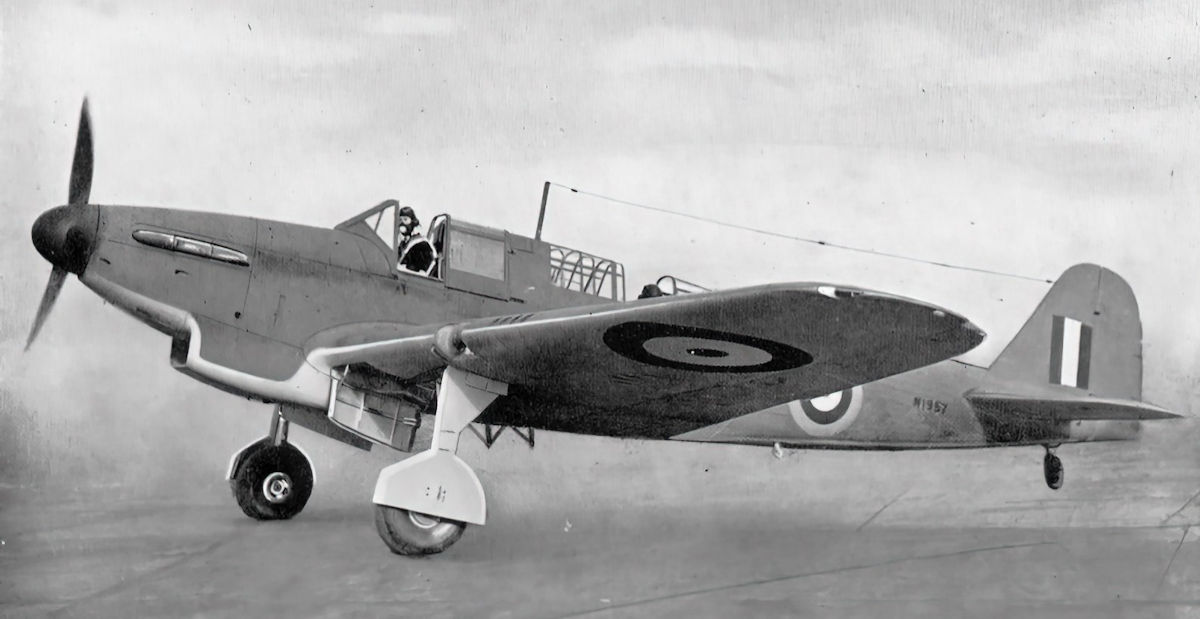
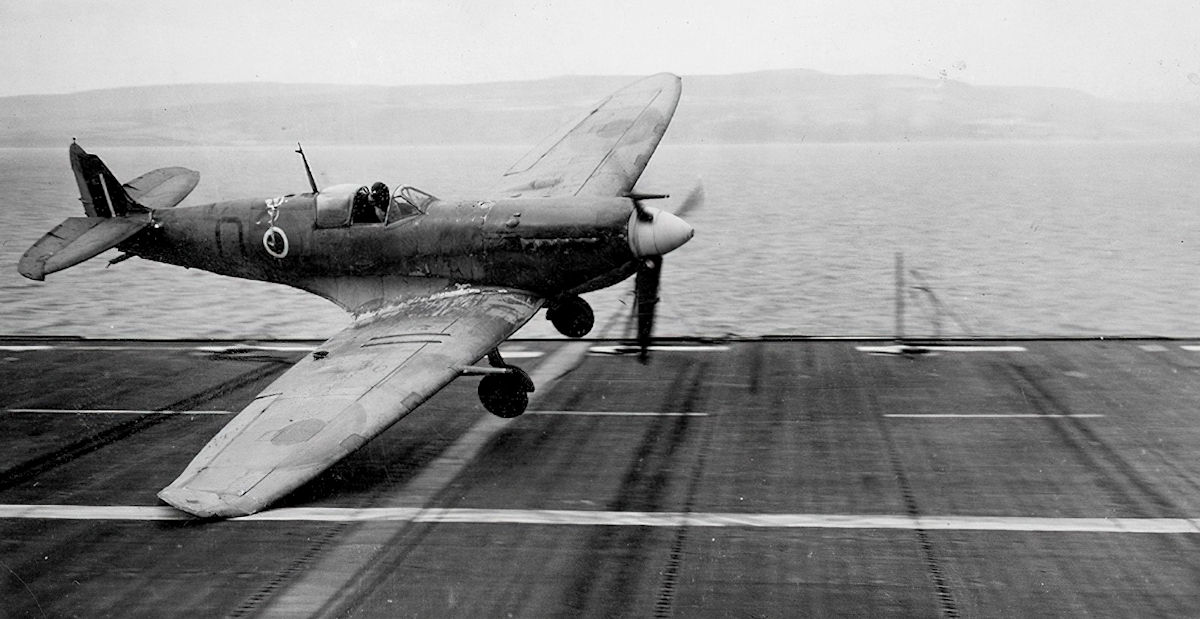
Transferring to RNAS Stretton on March 22nd 1943 the squadron re-equipped with Seafires; some hooked Spitfire Vb aircraft were issued initially for the conversion flying before ten Seafire lBs were received. On April 23rd they moved to RAF Dundonald, for a short combined operations course, returning to Stretton on May 1st. New aircraft were again received at the start of June, this time 10 Seafire L.IIc/LR.IIc which they took to No.36 (AC) Wing at RAF Andover for army co-operation training on June 17th. Form Andover the squadron moved to RNAS Machrihanish on July 8th in preparation for joining a carrier.
The squadron was allocated to join the escort aircraft carrier (CVE) HMS ATTACKER and they flew out to the ship on July 29th 1943, when she was operating in the Clyde area at the end of a five week post modification work up and flying training program. Also assigned to the ship were 886 squadron which operated 9 Seafire L.IIc & 6 Swordfish. The ship had been allocated to participate in upcoming allied invasion of Italy and she sailed from the Clyde at 14:00 hours on August 2nd in company with her sister CVEs BATTLER, HUNTER, and STALKER bound for Gibraltar. The four carriers and their escorts ran into a terrible storm in the Bay of Biscay which lasted thought the 3rd and into the 4th; the seas were so rough the ships had to heave to ride it out. All four carriers suffered storm damage and many aircraft were badly damaged, HUNTER suffered the worst of the damage and was forced leave the convoy to return to the UK. The remaining three carriers arrived at Gibraltar, at 18:00 hours on the 9th.
ATTACKER left Gibraltar at 1800 on August 31st 1943 and proceeded to Eers-el-Kebir, arriving at 09:00 on September 1st. She left there to rendezvous with SCYLLA and forces in company at 08:00 on the 5th September. This Force arrived at Malta at 07:00 on September 7th.
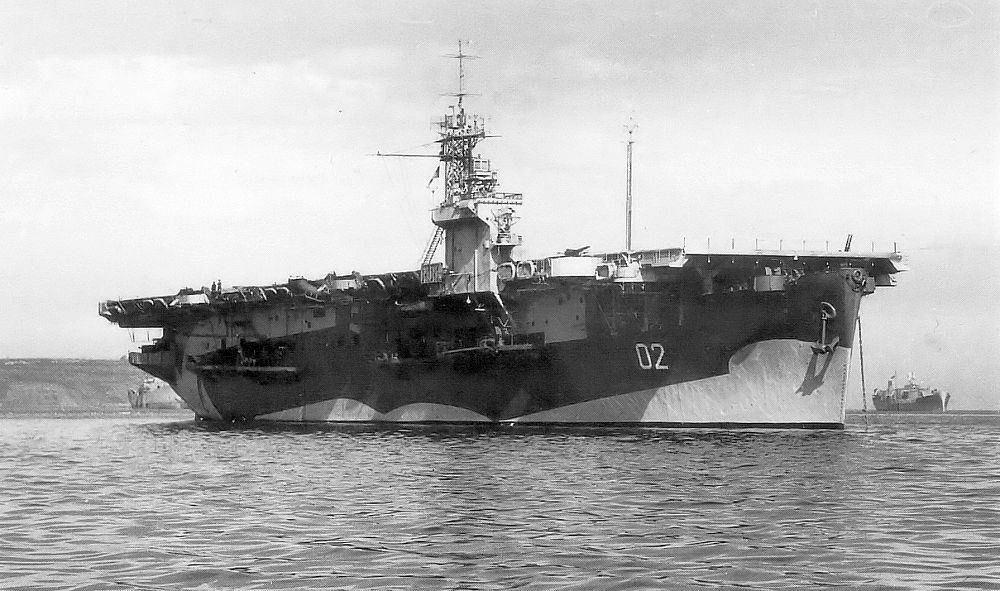
HMS ATTACKER in Bangor Bay, Northern Ireland.
On September 1st the four carriers became a part of Force 'V', the covering force for the allied invasion of Salerno Italy in operation AVALANCHE planned for operations between September 9 - 12th. Force 'V' comprised HM Escort Aircraft Carriers ATTACKER, BATTLER, HUNTER, STALKER and the maintenance carrier UNICORN (making a rare operational contribution), Cruisers EURYALUS [flagship], SCYLLA and CHARYBDIS, Destroyers CLEVELAND, HOLCOMBE, ATHERSTONE, LIDDESDALE, FARNDALE, CALPE, and Polish destroyers ORP SLAZAK and ORP KRAKOWIAK. A second force, Force ‘H’ comprised the Battleships NELSON, RODNEY, WARSPITE and VALIANT, Fleet Carriers ILLUSTRIOUS and FORMIDABLE and a screen of 21 destroyers including French, Polish and Greek warships was a covering force for the landings, intended to prevent any interference by Italian surface warships. On the eve of operation AVALANCHE Italy surrendered so the threat had passed, however there was a strong German force in the area.
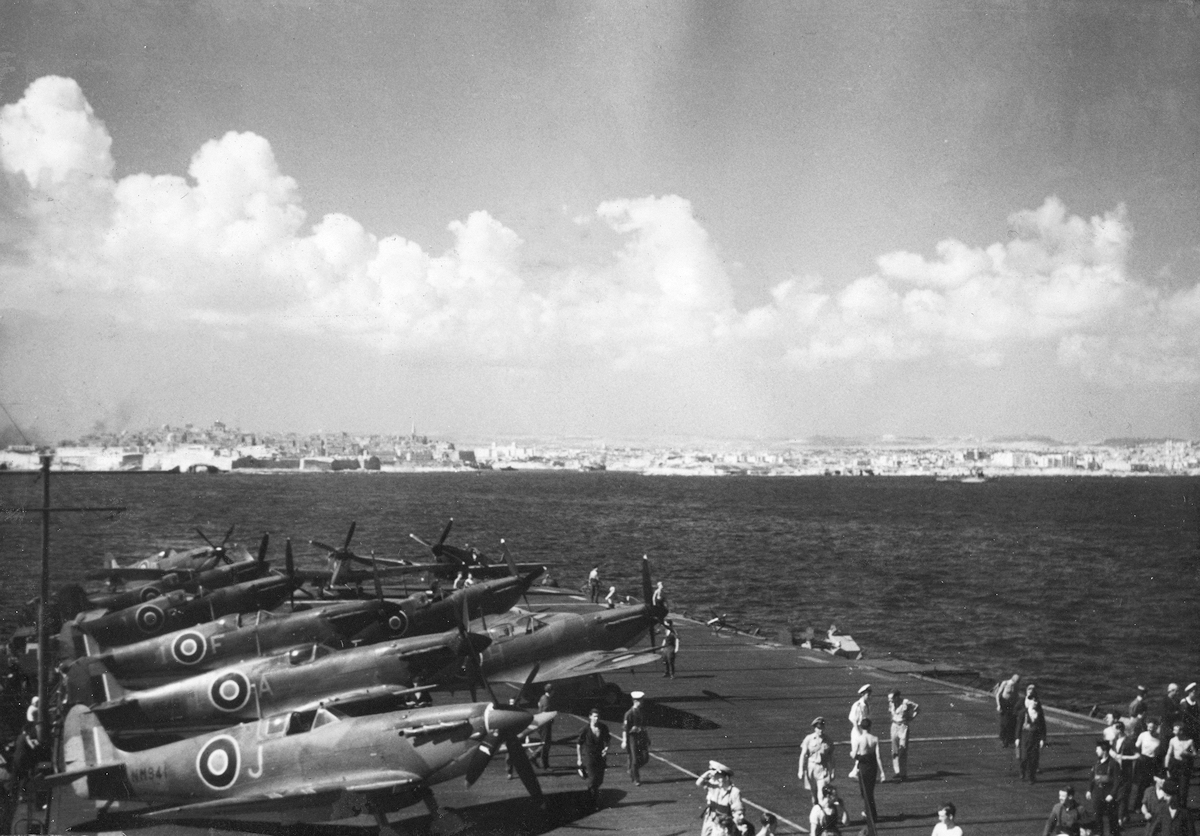
September 7th 1943, 879 squadron Seafires parked on the flight deck in Grand Harbour, Malta.
Force 'V' left Malta on the 8th
September and proceeded via the Straits of Messina arriving on
station 45 miles south-west of the beachhead early in the morning of
the 9th September. Each CVE in Force 'V' carried 2 Seafire
squadrons,
UNICORN 3, making a total of 109 aircraft in 11
squadrons. The five carriers were to provide fighter cover for the
landings. It was intended that a constant presence of naval air
cover would be maintained over the landing sites, up to 20 aircraft
aloft at a time. The first flights were launched at dawn on the 9th.
At this time none of the four CVEs were equipped as fighter or
assault carriers so fighter direction was provided by the Fighter
Direction Ship HMS ULSTER QUEEN.
Flying operations began at 06:15 and
continued throughout the day, with
ATTACKER’s last range landing on
at 19:15. During the last serial of the day, Sub-Lt G Calder
RNVR (879) in Seafire NM965, landing on under somewhat poor light
conditions, floated at speed over the arrester gear and crashed
through the barriers into aircraft parked forward; NM965 was a write
off, NM941 was pushed overboard by the impact, and rendering
another unserviceable for 18 hours. By the end of the first day’s
flying program all 52 planned sorties had been completed; 12
aircraft were serviceable, or made serviceable for the following
day. During the night
of the 9th/10th
September the Force preceded clear of the operational area,
returning on the morning of the 10th, when flying resumed at 06:15.
The day began with a tragedy when Ord. Seaman Edwin Kershaw, of the
Aircraft Handling Party, ran into a propeller and was
instantaneously killed. He was buried at sea at 11:00 on the same
day. Later that second day one of
BATTLER's aircraft landed on as
her deck was fouled, but approached at an excessive speed, crashed
through the barriers into aircraft parked forward, the pilot writing
off his own aircraft and severely damaging two others. At the end of
the second day's operations 8 aircraft were available or made
available for the following day.
At 06:15 on the 11th, flying resumed again, and operations continued throughout the day to the last
range at 18:31. Lieut. Morrison (879) landed at the emergency field
ashore with hook trouble. His hook was repaired by the R.A.F. and he
returned to the ship at 18:05. Sub-Lt Sturges (879) in NM944 was
unable to lower his undercarriage on returning to land on, and was
told to return to shore for an emergency landing on Salerno beach; the
aircraft was abandoned, he later rejoined the ship at Bizerta. At
the end of the third day's operations 5 aircraft were serviceable
or made serviceable for the following day. The attrition rate was
very high, all the CVEs required additional aircraft to be
transferred from the Fleet Carriers of Force H in order to continue
operations at this intensity (Force H withdrew to Malta on the 11th,
being nearly out of aircraft itself by this time).
At 06:15 on the 12th, the first
aircraft were flown off. 10 sorties were flown. It had been
envisaged that one or more enemy airfields would be in allied hands
by the end of the first day and so shore based air cover would take
over, this was not the case; it was not until the third day that the
airfield at Paestum was under Allied control that this became
possible. At 13:45 on the 12th as many serviceable fighters as could
be mustered were put ashore to operate at Paestum;
ATTACKER managed
4,
BATTLER 5,
HUNTER 5, and
STALKER only 2,
UNICORN supplied 10. At
approximately 18:30 the Force left the operational area and proceeded
to Palermo, arriving at 20:00. At 06:00 on the following morning the
Force sailed for Bizerta, arriving there at 19:00.
ATTACKER’s
detached aircraft re-joined the ship on the 17th.
During the four days on station the carriers, launched a combined total of 713 sorties, aircraft from ATTACKER flew 132 sorties; 879 squadron carried out 75 patrol sorties, 886 flew 57. No aircraft were lost to enemy action. Force 'V' was to disband on September 20th and ATTACKER, HUNTER and STALKER returned to the UK to refit and allow their squadrons the opportunity to receive replacement aircraft and aircrews.
On arriving on the Clyde on October 6th 879 disembarked to RNAS Machrihanish before moving to RAF Andover the following day. Meanwhile ATTACKER, and sister ships HUNTER and STALKER were to undergo conversion into assault carriers which would operate a single Seafire squadron apiece. These were to be 807, 809, and 879 squadrons, which were grouped together as the 4th Naval Fighter Wing which came into existence on October 25th 1943. while at RAF Andover 879 squadron received a new commanding officer , Lt. Cdr D. G. Carlisle, S.A.N.F.(V).
The squadron rrived at RNAS Burscough, Lancashire on November 29th, joining the other elements of No.4 Nava Fighter Wing. ATTACKER emerged from the dockyard in December and then took passage from Rosyth to the Clyde where she re-embarked the Seafires of 879 and 886 squadrons on December 29th to begin work up and training in her new role. On January 24th the ship sustained damage when HMS FENCER dragged anchor on the Clyde during gale conditions and collided with her; ATTACKER was ordered to Liverpool for further repair work to be carried out in early February, her squadrons flew ashore to RNAS Burscough on the 6th. The ship entered the Alexandra Dock on the 9th and would remain in dockyard hands for the next month. On February 24th 879 absorbed the Seafires, and some crews, of 886 Squadron to bring their strength up to 20 aircraft and 27 pilots. On the 16th 879 squadron rejoined the ship for nine days of flying, before being put ashore to RAF Long Kesh, Northern Ireland on the 24th for a more Army Co-operation training. The squadron rejoined the ship on April 30th and ATTACKER was allocated to join the Home Fleet for Operation HOOPS; this strike on Norwegian coast shipping with HUNTER and STALKER was scheduled for May 8th but was cancelled and the ships returned to Belfast.
All three assault CVEs and their squadrons were set to return to the Mediterranean, sailing on May 14th 1944. ATTACKER put into Gibraltar on May 24th, and two groups of 5 Seafires were disembarked to operate from RNAS North Front until June 5th. ATTACKER put to sea again with HUNTER, on June 6th, re-embarking the detached aircraft they sailed for Mers-el-Kebir, arriving the next day.
The ship moved on to Algiers on June 16th, and 6 aircraft were flown off to operate from the airfield at Blida, they were joined by four others on the 18th. 879 squadron was now effectively split 50/50 between the ship and various airfields engaged on Army co-operation flying with units in North Africa and Italy including Blida (Algeria) June 16th - July 22nd, Pomigliano (Italy) June 22nd - 25th, Capodichino (Italy) June 22nd - 26th, Orvieto (Italy) June 25th - July 19th and Castiglione (Italy) July 5th - 18th. The ship was escorting convoys in the western Mediterranean until the entire squadron was re-embarked by July 22nd when the ship withdrew to undertake a short self maintenance period in Malta.
At Malta ATTACKER joined Carrier Force TF88 for Operation DRAGOON, the invasion of Southern France. The Carrier Force comprised of the seven carriers of ReATTACKERar Admiral Troubridge’s Escort Carrier Squadron and two U.S. CVEs, divided into two Task Groups; TG 88.1 cruisers ROYALIST (Rear Admiral Troubridge, CTF 88 and CTG 88.1), anti-aircraft cruiser DELHI, CVEs ATTACKER (879 squadron with 28 Seafire), EMPEROR (800 squadron with 23 Hellcat), KHEDIVE (899 squadron with - 26 Seafire), PURSUER (881 squadron with 24 Wildcat), SEARCHER (882 squadron with 28 Wildcat), destroyers TYRIAN, TEAZER, TROUBRIDGE (Screen Commander), and US destroyers JEFFERS, H.P. JONES, MARSH, NIBLACK and MURPHY. TG 88.2 comprised of the CVEs USS TULAGI (Rear Admiral Durgin USN, CTG 88.2, VOF-1 - 24 Hellcat), USS KAZAN BAY (VF-74 - 24 Hellcat), HUNTER (807 squadron with 24 Seafire) and STALKER 809 squadron with 23 Seafire), anti-aircraft cruisers CALEDON and COLOMBO, 6 US destroyers.
TG88.1 sailed for tactical exercises off Malta on August 1st, putting to sea at 07:30. The force continued to exercise off Malta until the 11th. The ships of TG88.1 sailed from Malta at 18:00 on August 12th to proceed to the flying off position, they were followed by TG 88.2 at 18:30.
Operation DRAGOON commenced in the early hours of August 15th, TF88 flying operations commenced at 06:00, the last aircraft landed on at 20:35. Only daylight flying operations were carried out. The assault area, centred on Saint-Tropez, extended some 30 miles along the Cote d'Azur. It was divided into four sectors, code named (from east to west) Camel, Delta, Alpha and Sitka. The assault troops were formed of three American divisions of the VI Corps, reinforced by the French 1st Armoured Division. The 3rd Infantry Division landed on the left at Alpha Beach (Cavalaire-sur-Mer), the 45th Infantry Division landed in the centre at Delta Beach (Saint-Tropez), and the 36th Infantry Division landed on the right at Camel Beach (Saint-Raphaël). A fourth Force, the First Special Service Force, a joint U.S.-Canadian special forces unit was landed on the offshore islands for ‘Operation Sitka’ to neutralise the Hyères Islands, (Porquerolles, Port-Cros, Bagaud, and Levant). By the end of the first day, 60,150 troops and 6,737 vehicles had been put ashore, including the first French armoured contingent.
On ‘D’ Day, August 15th, ATTACKER and TG 88.1 were at the flying off position at 05:30 and 879 squadron had 28 serviceable aircraft that could be tasked with any of six mission types: Fighter Bomber (F/B), Strafing, Tactical Reconnaissance (TacR), Force Cover, Beach Cover, and Bombardment Spotting (Spotting was a secondary mission for the Seafires of ATTACKER and KHEDIVE with only 8 Pilots in each ship trained, whereas PURSUER and SEARCHER had 12 wildcat pilots trained in each ship). 879 Sqn had 28 aircraft on board (24 Seafire L.III – fighter and fighter bomber, 19 of which were equipped for dive bombing, and 4 Seafire LR.IIc – general purpose and photo recon), and limited reserves aircraft held ashore at Casabianda airfield in Corsica.
A pre-planned flying programme had been promulgated covering the first 5 days of operations, ‘D’ to ‘D’ + 4. The programme for D-Day called for the squadron to fly 38 sorties; 24 F/B, 4 Force Cover and 2 TacR. This however was not fixed, calls for strikes on enemy positions or additional spotting sorties could be passed to the ship throughout the day. Operations commenced at 06:00 with the launch of 4 F/B aircraft, the first of 8 such serials; low cloud and haze prevented the identification of many targets, and some aircraft encountered light flak. During the forenoon, one F/B serial was sent to bomb coastal fortifications. Initial results were, however, disappointing as the targets wore obscured by a ground mist. Alternative targets, the enemy's communications leading into the assault area towards Saint-Tropez were therefore bombed. Tactical Reconnaissance was carried out along the main inland roads between Nice, and Toulon well into the interior. A number of interesting and useful photographs were taken and reports of enemy movement were rendered. No enemy aircraft were encountered.
During the day 879 flew the programmed thirty-eight sorties. Very light winds of 18 knots over the deck meant that aircraft had to utilise the full length of deck for the take-off run and landing was also affected by the higher landing speeds which had the potential to result in deck crashes. . Two aircraft put out of action through barrier crashes, LR759 flown by Sub Lt D.A. Gibson, RNVR and LR692 flown by Sub-Lt J. G. Hornshaw, the later was so badly damaged the airframe was jettisoned to clear the deck. Another consequence of the low wind was mist and haze; the coast was not visible and only the smoke of explosions could be seen from the ship.
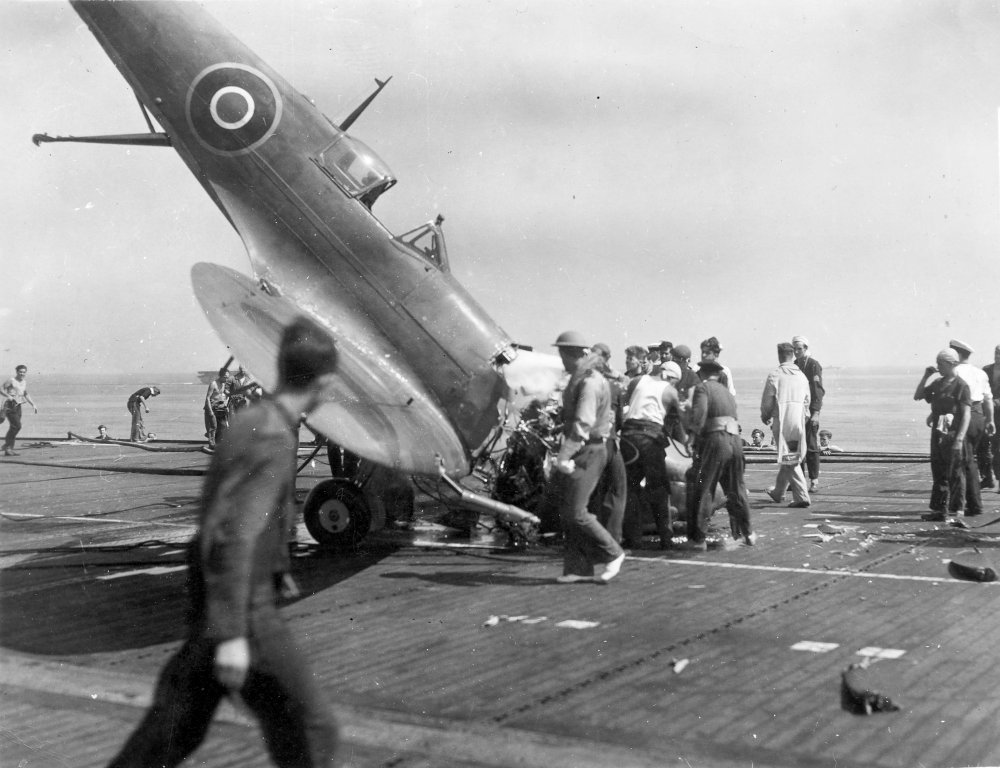
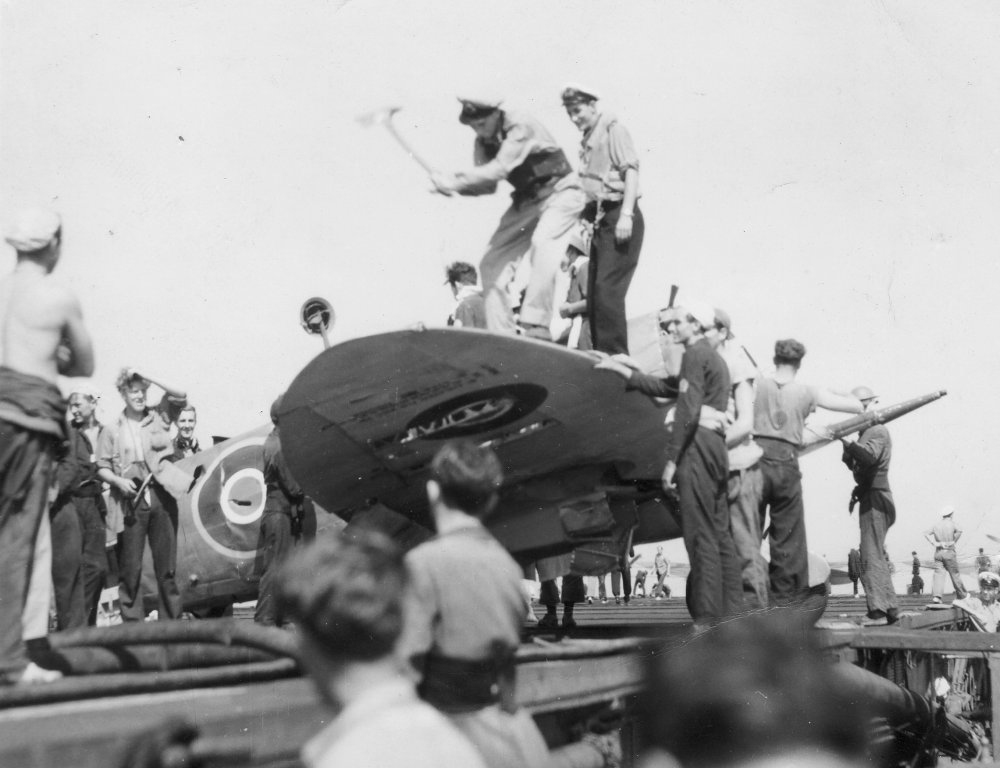
On D+1 879 had 26 serviceable aircraft and 24 pilots available at dawn. At 06:00 4 F/B and 4 TacR aircraft were ranged on deck on call but did not launch. The prepared flying programme called for 16 sorties; 4 F/B (on call), 4 TacR (on call), and Force Cover. The first launch of the day was to be at 17:40 - 4 aircraft for Force Cover. A F/B mission lead by Lt. Cdr D. G. Carlisle, S.A.N.F.(V) which located a column of Motor Transport near St.Maximin (between Aix and Brignollcs) and attacked it with bombs and guns, a number of vehicles being destroyed and damaged., TacR sorties overed the same roads as the day before. In the afternoon Force Cover and an additional spotting mission were launched- 2 aircraft to provide bombardment spotting for the Cruiser AURORA in the Giens - Hyeres area, but the flight leader Sub Lt D. L. Gibson, RNVR failed to locate any targets worth shooting at and no bombardment was carried out.
During the day 879 flew 26 sorties: 8 F/B, 10 TacR, 6 Force Cover, and 2 spotter. One aircraft flown by Lt. P. J. P. Leckie, RNVBR received damage to its tail unit but returned to the ship OK.
On D+2 879 had 26 serviceable aircraft and 24 pilots available. Wind speeds increased slightly to a maximum of 25 knots across the deck. The prepared flying programme was the same as for D +1. Eight F/B aircraft launched at 09.30 on a bombing and strafing mission between Brignoles and Aix. Lt. Cdr Carlisle and Sub-Lt Hornshaw led their respective flights targeting a railway bridge, and though the bridge was not destroyed the road was cratered and they bombed and strafed dispersed M/T near Brignoles, exploding an ammunition wagon, destroying four vehicles and damaging a number of others.
An Army Co-operation mission was received in the afternoon to assist with a problematic target, a Fort on port Cros Island. This s fort was in dead ground, unreachable by ship's gunfire, and had been attacked by Wildcats from PURSUER and Hellcats from EMPEROR in the morning. In the late afternoon KHEDIVE and ATTACKER launched 8 500 Lb bomb equipped F/B Seafires each, to strike at the fort, the 16 aircraft were led by Lt .Cdr G. C. Baldwin, DSC, RN, No.4 Wing larder . Four direct hits were recorded on buildings within the Fort, 2 were destroyed. The Seafires then ranged inland and strafed railway sidings west of Brignoles.
The day’s TacR mission led by Lt. G. Ogilvy, RNR located and photographed a defence system south of Oraison. He also located a largo column of armoured vehicles and M/T, north rest of Aix-on-Provence. Shortly afterwards he met a squadron of American Hellcats which he was able to direct on to this target. Once the film was developed and printed on board copies were flown to, and dropped alongside the USS CATOCTIN, the amphibious force flagship, off Saint-Tropez.
During the day 879 flew 20 sorties: 16 F/B), and 4 TacR
On D+3 879 had 26 serviceable aircraft and 24 pilots available. The prepared flying programme was the same as for D +1. The flying programme vas comparatively light on August 18th with only 20 sorties being flown. These wore mainly TacR sorties with a small number of F/B. By this time the enemy was beginning to withdraw to the northwest and the TacR flights had to range further in land to locate targets for the F/B and Strafing sorties to attack.
During the day 879 flew 20 sorties: 8 F/B, and 12 TacR.
On D+4 879 squadron had 24 serviceable aircraft and 24 pilots available. The prepared flying programme was the same as for D+1. A combined TacR and Fighter strafing mission was launched on the 19th against M/T and troop movements in co-operation with Seafires from 899 Sqn on KHEDIVE, was the first ever attempted, and it proved successful. The TacR leader, Lt R. J. Sturges, RNVR (879 Sqn), put the Fighters on to two groups of targets and quantity of M/T was destroyed and damaged. Unfortunately one of KHEDIVE's pilots Sub-Lt D. A. Carey, RCNVR was killed during a low level attack on German motor vehicles, his aircraft NF661 was seen to fly into a hill at Fuveaux. He was pulled from the wreckage seriously injured and was taken on board PURSUER but died from his injuries on August 21st. This tactic of striking in areas behind enemy lines in the early stages of an operation, saw transport located by TacR aircraft being strafed by fighters fitted with long range tanks instead of bombs to reach the more inland areas covered by the TacR aircraft. As the operation progressed the aircraft had to probe every deeper inland to locate targets.
Later in the day a formation of tanks was attacked by Lt H. D. Easy, RNVR’s F/B flight. One received a direct hit from a 500 lb bomb (Sub-Lt D. A. Gibson, RNVR) and another was probably dammed by a near miss (Lt Easy). Two Lorries were hit by Sub Lt W. A. Clarke e in LR704 despite severe AA fire; however on returning to the ship his aircraft bounced and sailed over all the arrestor wires entered he barrier. [1]
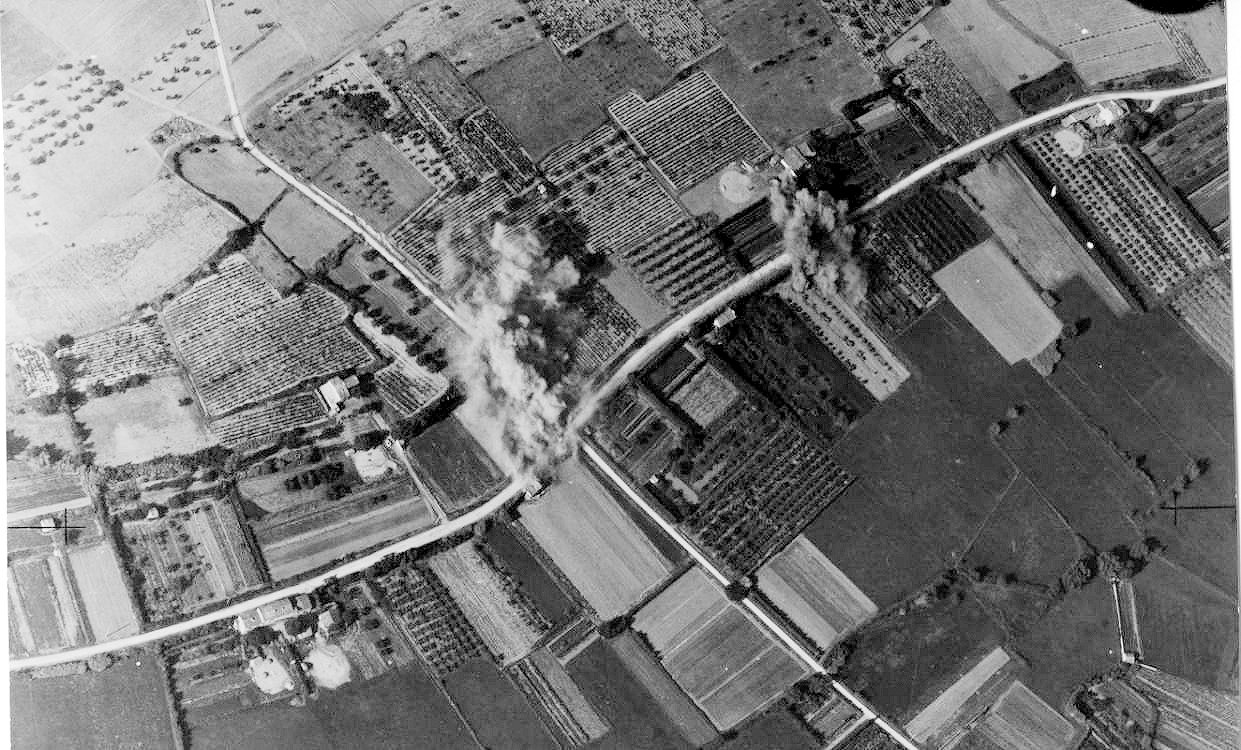
August19th 1944: The right hand smoke plume marks the spot where Sub Lt. Clarke's bombs landed while attacking a suspected German Tank during the invasion of Southern France. Photo courtesy of George Clarke.
Another sortie attacked a largo gun and tractor, completely destroying both, together with a staff car, a motor cycle and their respective drivers. Sub-Lt R. A. Gowan, RNZNVR also led a successful sortie of eight Fighter- Bombers which did severe damage to enemy communications between Salon and Orange. The aircraft came under heavy A.A. fire over the former town but skilfully avoided it.
During the day 879 flew 20 sorties: 8 F/B, 8 Strafing, and 4 TacR. One Seafire possibly out of action due to deck crash.
The two Task Groups of Force 88 had operated together for the first five days of the operation, but separated late on the 19th; ATTACKER, EMPEROR, PURSUER, and SEARCHER withdrew to Maddalena, Sardinia for a 24 hours replenishment and rest period while KHEDIVE transferred to TG 88.2 to bolster that force which remained off the French coast providing air cover.
D+5, rest day: TG88.1 arrived at Maddalena at 08:00 on August 20th and the carriers anchored in Arcachon Bay. The pilots had a day’s rest but most of the ship's company were busy on maintenance work, embarking bombs, ammunition, petrol, stores, etc. The Force sailed at 18:00 to return to the operational area.
On D+6 TG88.1 carriers arrived t at the flying off point south of Marseilles at 06:00 on the 21st, 879 squadron had 24 serviceable aircraft and 24 pilots available. The programmed flying schedule had ended on D+5 so the carriers were now supplying sorties on request from the Bombardment co-coordinators and Amy Co-operation teams. A programme of TacR and F/B missions were carried out in the general area Salon - Avignon - Orange -Nimes - Arles, the main targets being a large quantity of German M/T and amour retreating northwards. Pilots engaged on TacR missions encountered low cloud and industrial haze together with smoke from forest fires started by the enemy, and were forced to operas at altitudes lower than those normally recognized as reasonably safe (about 6,000 foot). Far more heavy flak was encountered as the enemy continued its retreat and this caused the loss of two aircraft and prevented the F/B pilots from carrying out strafing attacks.
The first launch of the day was 4 TacR Seafires at dawn, these split into pairs to search for targets of opportunity; only one of each pair returned to the ship. Each pair was to have an aircraft shot down, Sub Lt G. Calder, RNVR was hit first; suffering damage from AA fire near Nimes he managed to make a forced landing in the countryside and avoided capture until allied forces found him. His wing man loitered in the area before his fuel levels made him head back to the coast, he landed on another carrier when it looked like his fuel was too low to make it to ATTACKER. Later that sortie Sub Lt A.I.R. Shaw', RNVR was hit by enemy AA fire after he successfully attacked German mobile artillery on a country road near Pont St.Esprit, his engine was on fire so he had to bail out over enemy territory [2] . He was soon captured but subsequently escaped and was helped by locals until the advancing allied forces reached his location. His wingman was flying in a camera equipped Seafire and he took photos of the parachute as it floated to earth, he arrived back on board safely. Both downed pilots eventually re-joined the squadron.
At approx. 14:00 a further 5 aircraft were put out of commission; Sub Lt W. A. Clarkein LR710, returning from a TacR sortie, caught his hook on a plate on the after lift, was thrown up over all the arrestor wires and cleared the barriers to continue on into the forward deck park, damaging LR643, NN128 & LR740; Sub Lt A. A. Gowan RNZNVR [3] was critically injured in the crash, he was still in the cockpit of his aircraft (NN128) having taxied forward into the aircraft park, his thigh was broken by LR740's airscrew which ripped through the cockpit door causing a serious compound fracture of the right femur, and was later transferred to the Naval Hospital, Maddalena. The fifth aircraft put out of commission was LR760, Lt Ogilvy caught No.5 wire but continued into the barrier.
During the day 879 flew 20 sorties, a mix of TacR and F/B: 2 Seafires lost to enemy fire, both pilots missing but safe 5 Seafires damaged in deck crashes but repairable. 1 pilot seriously injured.
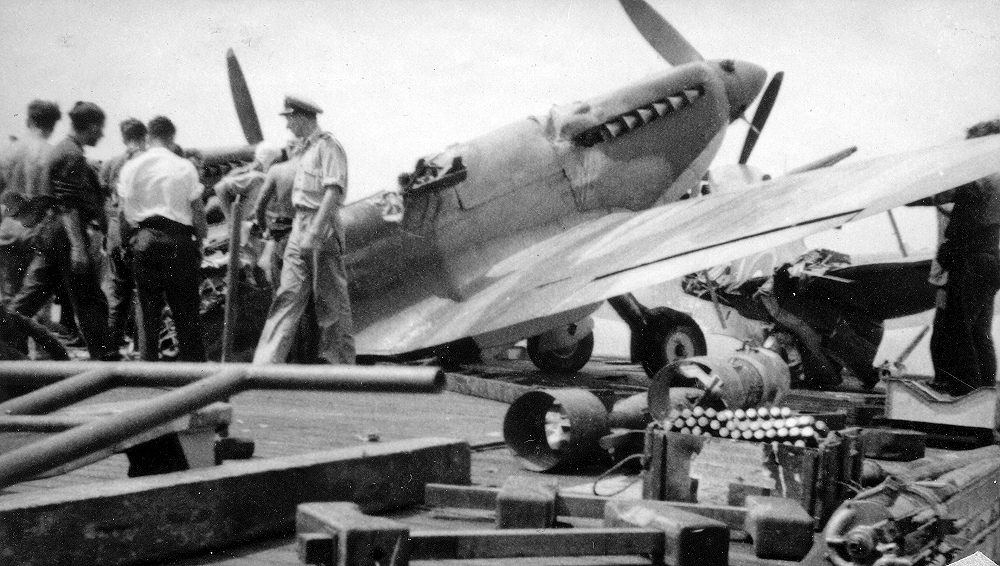
August 21st 1944: Seafire NN128 shortly after it was hit in the aircraft park by LR710 which had floated over all the arrestor wires, and the barrier to severely damage three other parked aircraft. Sub Lt A. A. Gowan RNZNVR was still in the cockpit of NN128 when the prop of LR710 tore through his cockpit door and severely damaged his right thigh. Sub Lt Clarke was unharmed. Photos courtesy of George Clarke.
On D+7 879 squadron had 17 serviceable aircraft and 21 pilots available. The flying off position was moved to the western side of the Gulf of Lyons in response to information that a German division was believed to be moving across from the Biscay coast. The division, however, moved north instead of east, and targets were hard to find in the new operational area west of the Rhone. KHEDIVE re-joined the force at 08:00.
TacR aircraft fromATTACKER extensively reconnoitered the Bezieres- Narbonne-Carcaconne area searching for signs of considerable amounts of heavy transports and armour on the move thereabouts reported by overnight intelligence reports. Some rail and road movements were located in the Béziers and Narbonne areas but good targets were hard to find, these were attacked by F/B aircraft and successfully bombed on several occasions. The same areas were also targeted by Seafires from KHEDIVE and Hellcats from EMPEROR.
During the day 879 flew 30 sorties, a mix of TacR and F/B: One aircraft took some flak damage but returned to the ship and landed safely.
On D+8 the force returned to the operating position south of Marseilles overnight, and attention was redirected to the Rhone Valley; 879 squadron had 18 serviceable aircraft and 21 pilots available.
Attention was redirected to the Rhone Valley and two pairs of TacR aircraft were flown off at 07:00, Lt Easy and his wingman located large amounts of traffic on the Rhone road heading north of Avignon and experienced hardy flak along the whole of the route. Sub-Lt Gibson and his wingman, working-r over minor roads further westward also located retreating transport but in smaller quantity and experienced much less flak. Throughout the morning 3 strikes of 8 F/B Seafires were launched to attack these targets.
However little moving M/T was located as strikes launched from the other carriers of TG88.1 had also been sent in to attack the same targets there was a large amount of damaged vehicles on the roads; on during one sortie about 120 wore found to have already berm destroyed. F/B strikes continued during the afternoon. As many serviceable vehicles as could be located were attacked and either damaged or destroyed. Later attention switched to bombing roads and railways which may have been used as an evacuation route by the German garrisons at Toulon and Marseilles.
During the final day of operations 879 had flown 40 sorties, a mix of TacR and F/B.
Flying operation for TG88.1 ended at 19:45 and the Force left the operational area at 21:00 for a second time to refuel and rearm and set course for Magdalena. TG88.2 arrived back on station at 06:30 on August 24th D+9 to resume operations. TG88.1 anchored in Arcachon Bay, Magdalena at 11:30 on the 24th. A further barrier crash occurred that morning when the arrestor hook of NN357, flown by Sub Lt R.I. Sturges, RNVR bounced off the deck and locked up.
The ships of TG88.1 were released from DRAGOON operations at dusk on Sunday August 27th, HUNTER and STALKER arrived at Maddalena at 10:45 on Monday August 28th and anchored in Arsachona Bay. At about 11:30, elements of TG88.1 left Maddalena later that day to proceed to Alexandria. ATTACKER left Maddalena on the 29th, having suffered a generator failure which held her departure up by 24 hours. A further barrier crash is recorded as happening on the 28th when Sub Lt Gibson flying in MB260 landed off centre, caught number 8 wire and hit the island. ATTACKER arrived at Alexandrian September 2nd to replenish stores, 879 squadron received replacement aircraft and aircrew from RNAS Dekhelia.
879 squadron's aircraft had completed 226 sorties including strikes on ground targets, bombardment spotting for HMS AURORA and tactical reconnaissance missions; 120 were bombing missions. The squadron began operations with 28 Seafires, at the end of DRAGOON operations on August 27th they had 17 serviceable machines, and no replacements had been received. Three aircraft were destroyed, 2 by enemy action, 1 damaged beyond repair by a barrier crash; 8 aircraft were damaged in deck landing crashes.
ATTACKER put to sea again on September 14th bound for the Aegean deployed for operation OUTING I and t to relieve HUNTER. She arrived on station on the 15th joining Force A with CVEs EMPEROR, KHEDIVE, PURSUER and SEARCHER, Cruisers ORION, AJAX, ROYALIST, BLACK PRINCE, ARGONAUT, AURORA, and COLOMBO; their task was to hamper and delay German troop movements in the Dodecanese Islands, (Leros, Kos, Samos, Rhodes and Levitha).
The squadron, which had been reduced to 20 aircraft (15 Seafire L.III and 5 Seafire LR.IIcs) flew armed reconnaissance sorties starting on the 16th, and ground attack missions on enemy transport, including dive-bombed shipping in Rhodes harbour on the 19th. Returning from a Force Cover sortie on the 19th Sub Lt W .A. Clarke suffered a barrier crash on Landing in Seafire LR704, after a hard three point landing the aircraft bounced and the tail wheel fell off, unable to regain airspeed the aircraft continued into the barrier.
ATTACKER withdrew to Alexandria on the 20th to re-supply. She sailed for the Dodecanese Islands on September 27th for the second phase of operations, OUTING II. Squadron strafed the W/T station on Levitha on the 3rd before conducting TacR flights on the 4th together with bombardment spotting for the cruiser ROYALIST. The force returned to Alexandria for a further replenishment of aircraft and stores on October 5th; ATTACKER's aircraft having completed 102 sorties.

Lt Cdr (A) G. C. Baldwin DSC RN, leader of No. Naval Fighter Wing begins his take-off run to lead a Fighter-Bomber force to attack shipping in Rhodes Harbour. Each aircraft has a 500lb bomb slung on the centreline hard point.
On her return to the Eastern Aegean ATTACKER again relieved HUNTER on October 11th, for the next offensive, Operation MANNA. ATTACKER operated as part of Force 120 from the 15th, with CVEs EMPEROR and STALKER, Cruisers AURORA, BLACK PRINCE, AJAX, ORION, Destroyers TROUBRIDGE, TERMAGANT, TUSCAN, TYRIAN and Polish ORP GARLAND to cover the reoccupation of Piraeus. STALKE left the force on the 20th, returning to Alexandria. On the 23rd and 24th railway rolling stock and motor transport was strafed and set on fire, and together with extensive dive-bombing of the railway system stopped all rail traffic on Kos. Towards the end of the month ATTACKER and EMPEROR provided air cover for amphibious landing at Mitylene on the island of Lesbos. On the 26th, aircraft from 87 squadron operated ashore at Mitylene until re-embarking to cover the landing on Piskopi on the 29th. ATTACKER withdrew to Alexandria on October 30th leaving EMPEROR as the only CVE operating in the area. 879 had flown 240 sorties between September 16th and October 29th.
On October 31st the three Assault Carriers, ATTACKER, HUNTER & STALKER sailed in company for the UK. Calling at Malta on November 3rd ATTACKER embarked 150 ratings for passage to the UK. The three carriers, and their squadrons. were earmarked for service with the 21st Aircraft Carrier Squadron (21 ACS), with the East Indies Fleet and were to undergo a short period of defect rectification while their crews and squadron personnel went on 2 weeks home leave. They reached Plymouth on November 10th and the ship was put in the hands of Devonport Naval Dockyard. Lt. Cdr P. E. I. Bailey RN assumed command of the squadron on November 9th, 1944.
On completion of this work the carriers sailed from Plymouth on November 29th bound for Gibraltar; all three were on passage to undergo refits in Mediterranean dockyards; STALKER was to refit in Gibraltar on their arrival on December 3rd so her squadron, 809 Seafires, had transferred to ATTACKER on leaving Plymouth and were disembarked along with 879 squadron to RNAS Dekheila, on December 11th. HUNTER proceeded to Malta for refit beginning December 6th. ATTACKER was to refit in the Italian port of Taranto.
The squadron was to remain ashore at NAS Dekheila for four months and the time was spent training in preparation for their next period of operations. There were three fatal crashes while the squadron was training in Egypt; on January 13th 1945 Sub Lt. N. I. MacLeod, RNZNVR died when he failed to pull NN124 out of a dive during a dive bombing exercise at Gianaclis No.5 bombing range. A second death happened during a dive bombing exercise at Gianaclis on January 29th when Sub lt. K. A. Cain's aircraft, NF429, struck the ground and exploded. The third incident was on February 12th when Sub Lt. D. V. Cross, RNVR was flying in NN450 on a low level TacR and his aircraft hit the ground and exploded 4 miles West of Damanhur.
Now equipped with 24 Seafire L.IIIs, the squadron re-embarked in ATTACKER on April 14th, Lt. Cdr (A) B. H. Harriss RN joining as the new C.O. The ship proceeded through the Suez Canal to Aden and on to Ceylon. The squadron disembarked to RNAS Katukurunda, on the west coast of Ceylon, on April 29th 1945. At RNAS Katukurunda the squadron began a training programme to work up the squadron which included a number of replacement pilots from the UK; training included formation flying, fighter tactics, bombing and gunnery and jungle survival. On June 5th a flight of 4 Seafires, on a routine Dive Bombing practice sortie took off from RNAS Katukurunda but encountered heavy clouds on reaching the range near Hambantota. With fuel levels low the flight leader decided they should make a precautionary landing on the dry lake bed that was the bombing range. RNVR Sub-Lts W. . Cody, R. C. Hallas, and J. R. Little successfully put theirs down on the cratered lake bed but the fourth, Sub- Lt. D. Armstrong, RNVR decided to attempt a landing on the nearby beach at Bundala but crashed and was killed. He was later buried in the naval cemetery at Colombo with full military honours.
The squadron re-embarked on June 10th, remaining aboard until July 7th, presumably on flying training, they then returned to RNAS Katukurunda. They re-embarked three days later as ATTACKER continued flying operations before taking passage to Trincomalee where they disembarked to RNAS Trincomalee on the 19th. This short ten day outing was a costly one for 879 squadron, 11 aircraft suffered damage through flying incidents, and one pilot was killed. The run of bad luck began the day the squadron re-embarked with Sub Lt B. Lees, RNZNVR putting NF445 into the barrier. On the 11th two aircraft 'pecked' the deck on landing, NF600 flown by Sub Lt G. H. Wilson RNZNVR and NN401 flown by Sub Lt M.D. S. McClelland, RNVR; Sub Lt I. H. Gladders made a heavy landing in NN437 resulting in the starboard tire bursting and buckling the oleo leg. A fourth incident on the 11th resulted in Sub Lt A. W. K. Foxon. RNVR being killed; his Seafire NN347 flew through the barrier damaging parked aircraft as it dived over starboard side into the sea. There were five more aircraft put out of action on the 12th, Sub Lt W. J. Cody, RNVR in NF643 hit the rounddown with his tail wheel causing damage to the fuselage; later that day he put NN408 into the barrier. Sub Lt L. Livemore, RNVR in NN365 also put his aircraft into the barrier, while Sub Lt G.H. Wilson RNZNVR flying NN451 caught a wire but his prop clipped the deck. While attempting to go round again, Sub Lt. HC Vane in NN397 hit the edge of the flight deck and the aircraft fell into the sea. The pilot was safely rescued. On the final day of flying before flying ashore to Trincomalee, Seafire NN437 flown by Sub Lt G. H. Wilson, RNZNVR suffered fuselage damage when a bomb carrier dislodged landing on.
While at Trincomalee those squadron pilots who had not done deck landing qualification flights from Katukurunda flew out to HUNTER for DLT between August 2nd through to the 16th. This was dangerous work and cost one pilot his life; Sub Lt. W. S. Jones , RNVR was killed when his aircraft stalled on approach to HUNTER and dived into the sea on August 4th.
Forces originally allocated to operation JURIST were Force 11, comparing the Battleship NELSON ( Flag, Vice Admiral Walker), escort carriers ATTACKER, HUNTER, SHAH and STALKER, the light cruisers CEYLON and NIGERIA, the destroyers PETARD, TARTAR and VOLAGE, and the landing ships PRINCES BEATRIX and QUEEN EMMA. Force 12 comprised the destroyers VERULAM and VIGILANT and eight yard minesweepers; Force 13 comprised the destroyer PENN and LST 383 loaded with vehicles; Force 14 with the escort destroyer CALPE and the Royal Fleet Auxiliary’s BELA and EMPIRE SALVAGE; Force 68 with the heavy cruiser LONDON (Flag, Commodore Poland) and destroyers RAIDER and ROCKET; and Force 157 with the Indian sloop GODAVARI, Coastal Forces repair ships BARRACUDA and MULL OF GALLOWAY, tanker CROMWELL, 26 motor launches of the 34th, 38th and 56th Motor Launch Flotillas, and nine harbour defence motor launches of the 110th Harbour Defence Motor Launch Flotilla.
With hostilities over attention turned to the reoccupation of former British territories held by Japanese forces, but it was to be late August before orders were received to send out naval forces to reoccupy key ports in Burma, Malaya and Singapore. Shortly after the JURIST forces took passage eastward delays in negotiations, and in the arrival of the Japanese Emperor's orders to cease hostilities in South East Asia became apparent; orders were issued postponing the start of JURIST and on August 20th all forces took shelter on the north east coast of Great Nicobar Island. ATTACKER and HUNTER were ordered to proceed to Rangoon.
Political constraints also meant that no landing could take place until after signing of surrender in Tokyo. These delays meant that all plans were now to change; the occupation of Penang was still to be undertaken as Operation JURIST but without the amphibious assault, and would include the occupation of Sabang, both objectives being occupied by contingents of Fleet Royal Marines.
ATTACKER and
HUNTER sailed from Rangoon on August 27th to rendezvous with NELSON and CEYLON off Penang. At mid-day on August 28th a reduced Force 11, NELSON, accompanied by CEYLON,
ATTACKER and
HUNTER, three destroyers and two large infantry landing ships carrying the Royal Marine landing party, arrived off George Town, Penang to negotiate the surrender of local Japanese forces and to reoccupy the area. At the same time LONDON, accompanied by one destroyer, arrived off the northern tip of Sumatra carrying a small contingent of Royal Marines to occupy Sabang Island. The Japanese forces surrender taking place on September 2nd.
The squadron continued to fly CAP throughout the operation.
ATTACKER and HUNTER sailed from George Town on September 7th and provided air cover for the passage of assault convoys through the Malacca Straits during the 8th and 9th for the modified Operation ZIPPER, the re-occupation of Port Swettenham and Port Dickson which began at first light on the 90th, before setting course for Singapore. The reoccupation of Singapore was achieved by Operation TIDERACE, allied forces had arrived in Singapore on September 4th, meeting no opposition. By 18:00 the Japanese had surrendered their forces on the island to Lieutenant-General Sir Philip Christison aboard HMS SUSSEX. The formal surrender was to be finalised on September 12th at Singapore City Hall. On the morning of Tuesday, September 11th, 1945 the ships of Admiral Walkers force (now designated Force 61) and Carriers of the 21st Aircraft Carrier Squadron anchored in Singapore Roads between 0930 and 1030 and waited for instructions. Later the order was given for part of the force to proceed into the harbour; EMPEROR, HUNTER KHEDIVE and STALKER anchored in Keppel Harbour. The CVEs AMEER and ATTACKER were among 90 ships (including 70 RN and RIN warships, 3 Royal Fleet Auxiliaries, 3 hospital ships and 14 merchant vessels) present in Singapore Roads for the ceremony in which the Japanese forces in South East Asia surrendered on September 12th.

September 1945 - HMS ATTACKER enters Singapore harbour, the ship is 'dressed' for entering harbour, a Seafire of 879 squadron stands on the flight deck wearing invasion markings.
HMS ATTACKER sailed from Singapore on September 14th bound for Trincomalee, arriving there on the 19th, 879 squadron disembarked to RNAS Trincomalee. The squadron was earmarked for return to the UK to receive new equipment and re-group, they re-embarked in ATTACKER on October 10th. She sailed for Bombay the following day, carrying many passengers and servicemen going home to be de-mobbed; after Bombay she called at Malta on route, arriving in UK waters on November 10th 1945. 879 squadron departed from the ship for the final time as she steamed up the Irish Sea, flying off to RNAS Nutts Corner, Northern Ireland.
On November 17th the squadron received 12 new Seafire XVlls at Nutts Corner, but was disband on January 7th 1946.
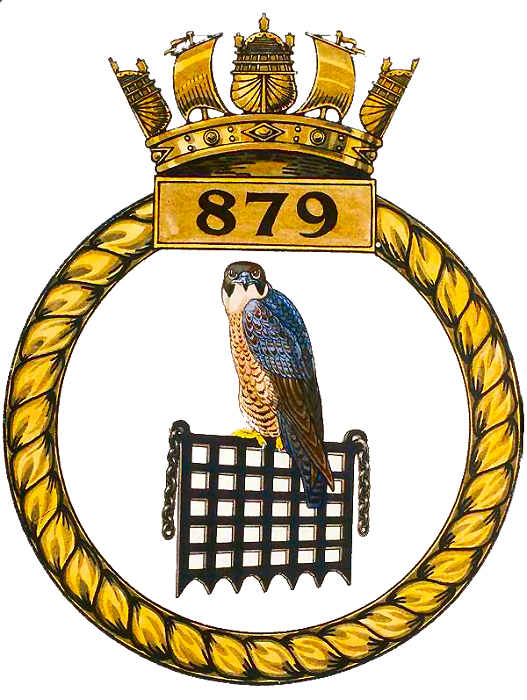
SALERNO 1943
SOUTH FRANCE 1944
AEGEAN 1944
Fulmar I II
Oct 42 - Mar 43
Spitfire Vb/hooked Mar 43
Seafire Ib, Mar 42 - Jun 43
Seafire L.II / L.IIc Mar 43 - Nov 45
Seafire F.XVII Nov 45 - Jan 46
Lt. S. F. F. Shotton RNR 30 Sep 42
Lt. Cdr (A) R. J. H. Grose RNVR 14 Jan 43
Lt. Cdr D. G. Carlisle, S.A.N.F.(V) 20 Oct 43
Lt. Cdr P. E. I. Bailey RN
9 Nov 44
Lt. Cdr (A) B. H. Harriss RN
14 Apr 45
Squadron disbanded 7 Jan 1946
© 1999-2024 The Royal Navy Research Archive All Rights Reserved Terms of use Powered byW3.CSS
Press F5 to refresh the page after posting your comment or to hide the form
Note: Sub Lt Clarke’s flying log book does not record this barrier crash, details drawn from Sturtivant, R. & Burrows, M. (1995) 'Fleet Air Arm Aircraft 1939 to 1945' indicate a barrier crash on this date. However another entry in the same book records a more damaging crash by Sub Lt Clarke in in LR710 on the 21st (D +6) which hit three other Seafires in the forward deck park. Only the latter is recorded in the pilot’s flying log book
CloseNote: Sub Lt Gowan RNZNVR was later awarded the DSC for skill and leadership in dive-bombing and strafing missions during 'Operation Dragoon'
CloseNote: In his account of the incident in his book 'Upside of trouble' Anthony Shaw gives the date as the 21st - the entry in ‘Fleet Air Arm Aircraft 1939 to 1945' by Sturtivant & Burrows the date is given as August 28th.
CloseNote: Several commentators have ATTACKER arriving at Taranto for refit on Dec 6th with squadron personnel taking passage to Egypt in the Italian cruiser DUCA D'AOSTA. However, squadron records show that the aircraft of both 809 and 879 squadrons were disembarked from ATTACKER on Dec 11th in Egypt.
Close
Comments (0)